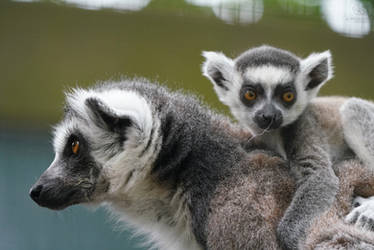ShopDreamUp AI ArtDreamUp
Deviation Actions
Description
Afterwork: Contrast, sharpened.
Lemur Exhibit, Indianapolis Zoo, Indianapolis, Indiana.
Lemur history
Madagascar lacks the dominant form of primate distributed worldwide, those of the suborder Haplorhini (monkeys, chimps, gorillas, and Homo sapiens). Instead, their niche has been filled by an older group of primates, the lemurs. Lemurs belong to the sub-order Strepsirhini together with bushbabies, lorises, and pottos which—like the original lemurs—are nocturnal, insectivorous primates characterized by a small body, a long nose, and large eyes. Lemurs have an interesting evolutionary history and the only reason they still exist today is because of Madagascar's isolation.
Until around 160 million years ago, Madagascar was attached to the African mainland as part of the super continent Gondwanaland (formed of Africa, South America, Australia, Antarctica, India, and Madagascar). As Gondwanaland broke apart, Madgascar moved away from Africa. The first lemur-like primates on the fossil record appeared roughly 60 million years ago in mainland Africa and crossed over to Madagascar shortly thereafter.
The island continued to drift eastward and by the time monkeys appeared on the scene 17-23 million years ago, Madagascar was isolated from their arrival. As highly intelligent and adaptive primates, monkeys quickly drove the lemur lineage elsewhere in the world toward extinction (a few Strepsirhines—including bushbabies, lorises, and pottos—managed to hang on by retaining their nocturnal, solitary, and insectivorous traits).
Madagascar's lemurs—isolated from evolutionary changes of the world—radiated into the large island's many niches without much competition or predation. Today lemurs are found in virtually all of Madagascar's ecosystems and share some of the social and behavioral characteristics of monkeys (i.e., forming social groups, eating fruit and vegetation, and being active during the day).
Upper primates did not reach Madagascar until about they learned to navigate the high seas and arrived on boats roughly 2,000 years ago. Humans quickly went to work on the island's lemurs, reducing the number of species found in Madagascar by at least 15. The largest species suffered the most and today the largest remaining lemur is the Indri which would have been dwarfed by the gorilla-sized species once found on the island. Currently all lemurs are endangered species, due mainly to habitat destruction (deforestation) and hunting.

`lns
Lemur Exhibit, Indianapolis Zoo, Indianapolis, Indiana.
Lemur history
Madagascar lacks the dominant form of primate distributed worldwide, those of the suborder Haplorhini (monkeys, chimps, gorillas, and Homo sapiens). Instead, their niche has been filled by an older group of primates, the lemurs. Lemurs belong to the sub-order Strepsirhini together with bushbabies, lorises, and pottos which—like the original lemurs—are nocturnal, insectivorous primates characterized by a small body, a long nose, and large eyes. Lemurs have an interesting evolutionary history and the only reason they still exist today is because of Madagascar's isolation.
Until around 160 million years ago, Madagascar was attached to the African mainland as part of the super continent Gondwanaland (formed of Africa, South America, Australia, Antarctica, India, and Madagascar). As Gondwanaland broke apart, Madgascar moved away from Africa. The first lemur-like primates on the fossil record appeared roughly 60 million years ago in mainland Africa and crossed over to Madagascar shortly thereafter.
The island continued to drift eastward and by the time monkeys appeared on the scene 17-23 million years ago, Madagascar was isolated from their arrival. As highly intelligent and adaptive primates, monkeys quickly drove the lemur lineage elsewhere in the world toward extinction (a few Strepsirhines—including bushbabies, lorises, and pottos—managed to hang on by retaining their nocturnal, solitary, and insectivorous traits).
Madagascar's lemurs—isolated from evolutionary changes of the world—radiated into the large island's many niches without much competition or predation. Today lemurs are found in virtually all of Madagascar's ecosystems and share some of the social and behavioral characteristics of monkeys (i.e., forming social groups, eating fruit and vegetation, and being active during the day).
Upper primates did not reach Madagascar until about they learned to navigate the high seas and arrived on boats roughly 2,000 years ago. Humans quickly went to work on the island's lemurs, reducing the number of species found in Madagascar by at least 15. The largest species suffered the most and today the largest remaining lemur is the Indri which would have been dwarfed by the gorilla-sized species once found on the island. Currently all lemurs are endangered species, due mainly to habitat destruction (deforestation) and hunting.
`lns
Image size
3456x2304px 3.86 MB
Make
Canon
Model
Canon EOS DIGITAL REBEL XT
Shutter Speed
1/500 second
Aperture
F/6.3
Focal Length
500 mm
ISO Speed
200
Date Taken
May 19, 2008, 11:24:42 AM
© 2008 - 2024 ladynightseduction





































